
Frans Hals the Elder was a Dutch Golden Age painter. He lived and worked in Haarlem, a city in which the local authority of the day frowned on religious painting in places of worship but citizens liked to decorate their homes with works of art. Hals was highly sought after by wealthy burgher commissioners of individual, married-couple, family, and institutional-group portraits. He also painted tronies for the general market.

Judith Jans Leyster was a Dutch Golden Age painter of genre works, portraits, and still lifes. Her work was highly regarded by her contemporaries, but largely forgotten after her death. Her entire oeuvre came to be attributed to Frans Hals or to her husband, Jan Miense Molenaer. In 1893, she was rediscovered and scholars began to attribute her works correctly.

The Proposition is a genre painting of 1631 by Judith Leyster, now in the Mauritshuis in The Hague, who title it Man offering money to a young woman. It depicts a woman, sewing by candlelight, as a man leans over her, touching her right shoulder with his left hand. He is offering her coins in his right hand, but she is apparently ignoring the offer and concentrating intently upon her sewing. As we see the female protagonist (seemingly) ignore the advances of her suitor, this painting has been considered to potentially be a feminist work.

Pieter Biesboer, is a Dutch art historian and prolific writer on 17th-century Dutch art. His specialty is art from Haarlem.

The Lute Player is an oil-on-canvas painting from 1623 or 1624 now in the Louvre by the Haarlem painter Frans Hals, showing a smiling actor wearing a jester's costume and playing a lute.
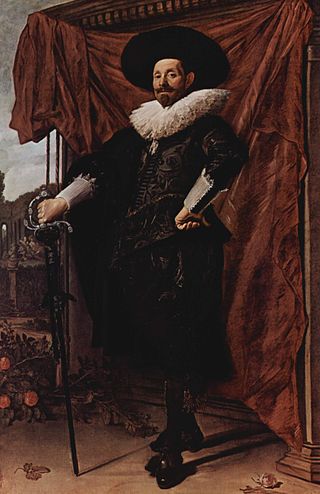
Willem van Heythuysen posing with a sword is an oil-on-canvas painting by the Dutch Golden Age painter Frans Hals, painted in 1625-1630, and now in the Alte Pinakothek, in Munich. It shows the Haarlem cloth merchant Willem van Heythuysen in a theatrical pose with a rapier.

Boy with a Glass and a Lute is an oil-on-canvas painting by the Dutch Golden Age painter Frans Hals, painted in 1626 and now in the Guildhall Art Gallery, London.
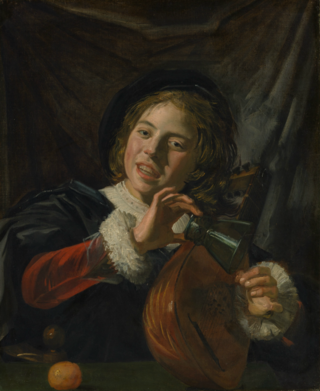
The Fingernail Test is an oil-on-canvas Dutch Golden Age painting that has been attributed to either Frans Hals or Judith Leyster, painted in 1626 and now in the Metropolitan Museum of Art, New York City.
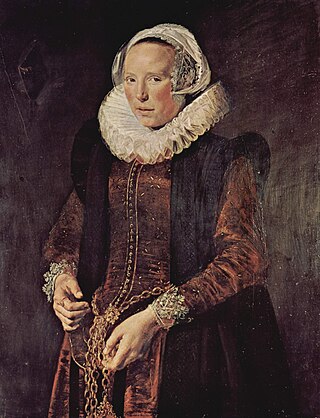
Portrait of a Woman Standing is a painting by the Dutch Golden Age painter Frans Hals, painted in 1610–1615 and now in Chatsworth House. It is considered a pendant portrait, but the sitter is unknown and therefore the pendant is not certain.
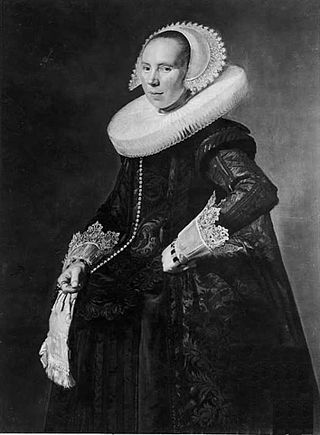
Portrait of Cunera van Baersdorp is an oil-on-panel painting by the Dutch Golden Age painter Frans Hals, painted in 1625 and now in a private collection. It is considered a pendant portrait to the Portrait of a Man Standing, now identified as Cunera's husband Michiel de Wael.

Self-portrait by Judith Leyster is a Dutch Golden Age painting in oils now in the collection of the National Gallery of Art in Washington DC. It was offered in 1633 as a masterpiece to the Haarlem Guild of St. Luke. It was attributed for centuries to Frans Hals and was only properly attributed to Judith Leyster upon acquisition by the museum in 1949. The style is indeed comparable to that of Hals, Haarlem's most famous portraitist.
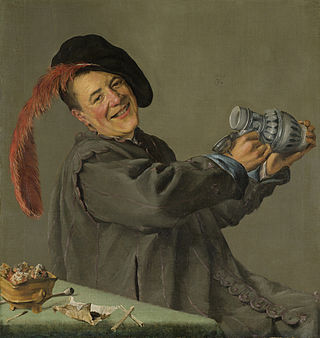
The Jolly Toper is a 1629 oil painting by the Dutch artist Judith Leyster in the collection of the Rijksmuseum that is on long-term loan to the Frans Hals Museum since 1959. It was acquired by the museum as a painting by Frans Hals and was attributed to Leyster by the researcher Juliane Harms in 1927.

The Serenade is a 1629 oil painting by Judith Leyster in the collection of the Rijksmuseum. It was attributed for centuries to Frans Hals until Wilhelm von Bode saw it in the Six collection in 1883. He noticed the prominent "J" in the signature, and attributed it to Jan Hals. This is one of seven paintings first properly attributed to Leyster by Hofstede de Groot ten years later in 1893.

The Merry Trio is an oil painting created in 1629 by the Dutch Golden Age painter Judith Leyster. It is now in a private collection. It was considered a work by Frans Hals until 1903.

The Last Drop is a c. 1629 oil painting by Judith Leyster in the John G. Johnson collection of the Philadelphia Museum of Art. It was regarded as a work by Frans Hals until 1903, when it was noticed that it is signed 'JL*' on the tankard.

A Youth with a Jug is a 1633 oil painting by Judith Leyster currently in a private collection.

Young man playing the lute is an oil painting executed in 1624 by the Dutch Golden Age artist Judith Leyster. It is now in the collection of the Rijksmuseum, and is a period copy of the same subject by Frans Hals. It was acquired by the museum as a painting by Frans Hals and was skipped by the researcher Juliane Harms in 1927, being finally attributed to Leyster by Seymour Slive in 1974.

The following is the list of 145 paintings indexed as autograph by Frans Hals, written by the art historian and Hals specialist Claus Grimm in 1989. The list is by catalogue number and is more or less in order of creation, starting from around 1610 when Hals began painting on his own. Most of these works are still considered autograph, though one has since been reattributed to Judith Leyster. In addition to this list, Grimm added comments and additional entries to Seymour Slive's lists of lost and doubtful paintings. He also rejected several Slive attributions, making his list is considerably shorter. The autograph catalogue entries are as follows:
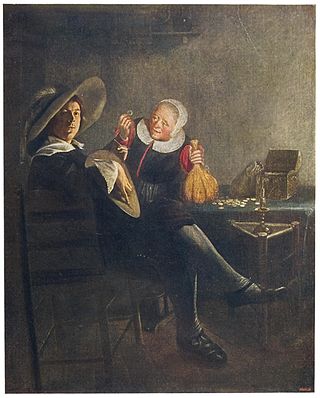
Unequal Love is a painting made in about 1631 by the Dutch Golden Age painter Judith Leyster. It is in the collection of the Galleria Nazionale d'Arte Antica, Rome.




















